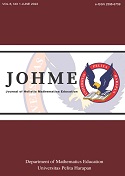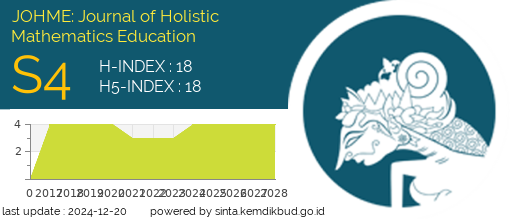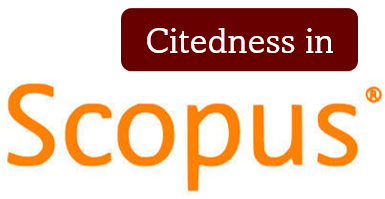THE EFFECT OF THE EUCLIDEAN GEOMETRY SHORT LEARNING PROGRAMME USING THE WORKED-OUT EXAMPLES TEACHING APPROACH ON MATHEMATICS TEACHERS' PERFORMANCE
DOI:
https://doi.org/10.19166/johme.v6i1.5264Keywords:
Euclidean geometry, intervention, performance, scaffolding, worked-out examples teaching approach.Abstract
The studies on the worked-out examples teaching approach (WOETA) have been investigated globally and in South Africa, showing gains in learners' performance. This study reports on the Euclidean geometry short learning programme (EGSLP), which used worked-out examples teaching approach (WOETA) intervention to secondary mathematics teachers enrolled in one university campus in the Free State province. This study used one group pretest-posttest research design.65 participants completed the pre-test, participated in WOETA, and later completed the post-test. The WOETA engaged the participants in the Euclidean geometry six topics, straight-line geometry, classification of triangles, Pythagoras, similarity and congruency, properties of polygons, and measurement that helped them to acquire procedural and conceptual knowledge. The findings revealed that the WOETA improved the participants' performance in two topics, straight-line geometry and classification of triangles. In contrast, it failed in four topics Pythagoras, similarity and congruency, properties of polygons, and measurement. Cronbach alpha was used to calculate the reliability of the pre-test and was 0,52, while the post-test reliability was 0.30, and these values were deemed not acceptable and not reliable. The findings also revealed that the WOETA does not affect participants' Euclidean geometry performance.References
Abdullah, A. H., & Zakaria, E. (2012). The effects of van Heile's phases of learning geometry on students' degree of acquisition of van Heile's levels. Procedia - Social and Behavioral Sciences, 102, 251-266. https://doi.org/10.1016/j.sbspro.2013.10.740
Alreshidi, N. A. K. (2021). Effects of example-problem pairs on students' mathematics achievements: A mixed-method study. International Education Studies, 14(5), 8-18. https://doi.org/10.5539/ies.v14n5p8
Baars, M., Visser, S., van Gog, T., de Bruin, A., & Paas, F. (2013). Completion of partially worked-out examples as a generation strategy for improving monitoring accuracy. Contemporary Educational Psychology, 30, 395-406. https://doi.org/10.1016/j.cedpsych.2013.09.001
Bell, B. A. (2010). Pretest-posttest design. In N. J. Salkind (Ed.). Encyclopedia of research design, 1087-1091. Thousand Oaks, CA: Sage Publisher.
Bicer, A., Perihan, C., & Lee, Y. (2022). Pre”‘service teachers' preparations for designing and implementing creativity”‘directed mathematical tasks and instructional practices. Mathematics Education Research Journal, 1-31. https://doi.org/10.1007/s13394-022-00409-x
Crowley, M. L. (1987). The van Hiele model of the development of geometric thought. In M. M. Lindquist (Ed.). Learning and teaching geometry, K-12: 1987 yearbook of the national council of teachers of mathematics, 1-16. Reston, VA: National Council of Teachers of Mathematics.
Edelsbrunner, P. A., & Grimm, H. (2021). Accommodating heterogeneity: The interaction of instructional scaffolding with student preconditions in the learning of hypothesis-based reasoning. Retrieved from https://www.researchgate.net/publication/355259160_Accommodating_Heterogeneity_The_Interaction_of_Instructional_Scaffolding_with_Student_Preconditions_in_the_Learning_of_Hypothesis-Based_Reasoning
Haber, J. (2021). It's time to get serious about teaching critical thinking. Retrieved from https://www.insidehighered.com/views/2020/03/02/teaching-students-think-critically-opinion
Iltüzer, Y., & Çevik, Y. D. (2021). Effects of self”‘explanation on applying decision rules in an online learning environment. Educational Information Technology, 26, 4771-4794. https://doi.org/10.1007/s10639-021-10499-y
Jones, K. (2002). Issues in the teaching and learning of geometry. In L. Haggarty (Ed.). Aspects of teaching secondary mathematics: Perspectives on practice, 121-139. London, UK: Routledge/Falmer.
Khatri, P. (2021). Importance of scaffolding. Retrieved from https://doi.org/10.29173/writingacrossuofa2
Kim, J. Y., & Lim, K. Y. (2019). Promoting learning in online, ill-structured problem solving: The effects of scaffolding type and metacognition level. Computers & Education, 138, 116-129. https://doi.org/10.1016/j.compedu.2019.05.001
Liao, H. (2019). Connecting principled information and worked examples: Effects of content abstractness and solution complexity. Bulletin of Educational Psychology, 50(4), 707-727. Retrieved from https://www.airitilibrary.com/Publication/alDetailedMesh?DocID=10115714-201906-201907310003-201907310003-707-727
Manson, E., & Ayres, P. (2021). Investigating how errors should be flagged and worked out examples structured when providing feedback to novice learners of mathematics. Educational Psychology, 41(2), 153-171. https://doi.org/10.1080/01443410.2019.1650895
Mason, M., (2002). The van Hiele levels of geometric understanding. Retrieved from http://jwilson.coe.uga.edu/EMAT8990/GEOMETRY/Mason,%20Marguerite.%20The%20van%20Hiele%20Levels%20of%20Geometric%20Understanding.%202002.pdf
Meyer, D. K., & Turner, J. C. (2002). Using instructional discourse analysis to study the scaffolding of student self-regulation. Educational Psychologist, 37(1), 17-25. https://doi.org/10.1207/S15326985EP3701_3
Ngirishi, H., & Bansilal, S. (2019). An exploration of high school learners' understanding of geometric concepts. Problems of Education in the 21st Century, 77(1), 82-96. https://doi.org/10.33225/pec/19.77.82
Nikoloudakis, E., & Dimakos, G. (2009). Using learning objects to teach Euclidean geometry. Proceedings of Workshop in Education Athens, 277-286. Retrieved from https://www.researchgate.net/publication/202298819_Using_Learning_Objects_to_teach_Euclidean_Geometry
Ӧzcan, Z. Ç. (2017). The effect of self-explanation prompts and fading steps in worked-out examples on students' fraction problems performance. Kalem Eğitim ve İnsan Bilimleri Dergisi, 8(1), 39-62. https://doi.org/10.23863/kalem.2017.82
Risnawati, Andrian, D., Azmi, M. P., Amir, Z., & Nurdin, E. (2019). Development of a definition maps-based plane geometry module to improve the student teachers' mathematical reasoning ability. International Journal of Instruction, 12(3), 541-560. https://doi.org/10.29333/iji.2019.12333a
Renkl, A., Hilbert, T. S., Schworm, S., & Reiss, K. (2007). Cognitive skill acquisition from complex examples: A taxonomy of examples and tentative instructional guidelines. In M. Prenzel (Ed.). Studies on the educational quality of schools: The final report of the DFG priority programme, 239-250. Münster, Germany: Waxmann.
Shongwe, B. (2019). Exploring grade 11 learners' functional understanding of proof in relation to argumentation in selected high schools. Retrieved from https://researchspace.ukzn.ac.za/bitstream/handle/10413/18294/Shongwe_Benjamin_2019.pdf?sequence=1&isAllowed=y
Shongwe, B. (2020). Learners' functional understandings of proof (LFUP) in mathematics: A qualitative approach. International Journal of Innovation in Science and Mathematics Education, 28(3), 24-36. https://doi.org/10.30722/IJISME.28.03.003
Sibiya, M. R. (2020). A reconsideration of the effectiveness of using geogebra in teaching Euclidean geometry. EURASIA: Journal of Mathematics Science and Technology Education, 16(9), 1-10. https://doi.org/10.29333/ejmste/8360
Sweller, J., van Merriënboer, J. J. G., & Paas, F. (2019). Cognitive architecture and instructional design: 20 years later. Educational Psychology Review, 31(2), 261-292. https://doi.org/10.1007/s10648-019-09465-5
Tachie, S. A. (2020). The challenges of South African teachers in teaching Euclidean geometry. International Journal of Learning, Teaching and Educational Research, 18(8), 297-312. https://doi.org/10.26803/ijlter.19.8.16
Thompson, D. R., Senk, S. L., & Johnson, G. J. (2012). Opportunities to learn reasoning and proof in high school mathematics textbooks. Journal for Research in Mathematics Education, 43(3), 253- 295. http://www.nctm.org/publications/article.aspx?id=33073
Tropper, N., Leiss, D., & Hänze, M. (2015). Teachers' temporary support and worked-out examples as elements of scaffolding in mathematical modeling. ZDM, 47(7), 1225-1240. http://dx.doi.org/10.1007/s11858-015-0718-z
Ubah, I., & Bansilal, S. (2019). The use of semiotic representations in reasoning about similar triangles in Euclidean geometry. Pythagoras, 40(1), 1-10. https://doi.org/10.4102/pythagoras.v40i1.480
Van der Pol, J., Volman, M., & Beishuizen, J. (2010). Scaffolding in teacher-student interaction: A decade of research. Educational Psychology Review, 22(3), 271-296. https://doi.org/10.1007/s10648-010-9127-6
Van Gog, T., Kester, L., & Paas, F. (2011). Effects of worked examples, example-problem, and problem example pairs on novices' learning. Contemporary Educational Psychology, 36(3), 212-218. https://doi.org/10.1016/j.cedpsych.2010.10.004
Van Putten, S., Howie, S., & Stols, G. (2010). Making Euclidean geometry compulsory: Are we prepared? Perspectives in Education, 28(4), 22-31. Retrieved from https://journals.ufs.ac.za/index.php/pie/article/view/51
Vojkuvkova, I. (2012). The van Heile model of geometric thinking. WDS 12 Proceedings of Contributed Papers Part 1, 72-75. Retrieved from https://www.mff.cuni.cz/veda/konference/wds/proc/pdf12/WDS12_112_m8_Vojkuvkova.pdf
Zormelo, B. (2018). Investigating the effect of using worked-out examples teaching approach when teaching properties of special quadrilaterals in grade 10 geometry [Master’s Thesis]. South Africa: University of South Africa. Retrieved from https://d1wqtxts1xzle7.cloudfront.net/59911685/ZORMELO_B._final_MEd._desertation_for_final_submision_201820190702-127336-1so9rmj-with-cover-page-v2.pdf?Expires=1653873333&Signature=SluCweyt3E-u2J94~XMbQgFoe9AZoWZGGaWrZS8fbE5a~OdDWm3PTgPN~AMXkJRrN7yjq31eJ7somQ43hvqPZh4~4Ev44Xb4Ij4GJMO~qDRxfAs4Q3~fQS~r0TB1~NGPDbdnwBMYRhn6PeVR98o9PdYbsR1vtWhOOO9wL5tq38kIMnAatO-19F2-fgI9Omr3FPjL9UAj7Iv2wCQtOmY7E6BM1z7CpZu~QC61cKCW3K1TY~GHdTyz36ExY7WAYgJG~SJkeu8-EGMKQawPfcy4iP6H8Uh10yGUCxsMxNHnjhHSm~7C8E7EfATIA8Z3WnODV8X14y2uq49n-IW0e9AhyQ__&Key-Pair-Id=APKAJLOHF5GGSLRBV4ZA
Downloads
Additional Files
Published
How to Cite
Issue
Section
License
Authors who publish with this journal agree to the following terms:
1) Authors retain copyright and grant the journal right of first publication with the work simultaneously licensed under a Creative Commons Attribution License (CC-BY-SA 4.0) that allows others to share the work with an acknowledgement of the work's authorship and initial publication in this journal.
2) Authors are able to enter into separate, additional contractual arrangements for the non-exclusive distribution of the journal's published version of the work (e.g., post it to an institutional repository or publish it in a book), with an acknowledgement of its initial publication in this journal.
3) Authors are permitted and encouraged to post their work online (e.g., in institutional repositories or on their website). The final published PDF should be used and bibliographic details that credit the publication in this journal should be included.”










